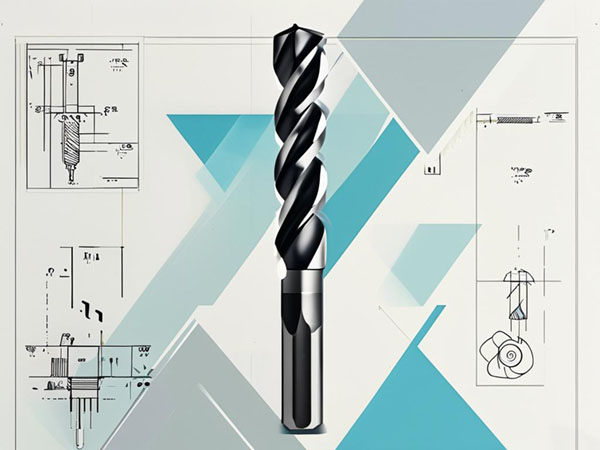
1. Definition and Classification of Flute Geometry
Flute geometry refers to the shape and arrangement of the grooves or channels on a milling cutter that are crucial for chip removal, cooling, and tool stability during machining. The design of the flute directly influences the cutting performance and efficiency of the milling tool.
Common types of milling cutter flutes include:
Straight Flutes: These are straight grooves and are typically used for lighter, lower-speed cutting operations. They are simple and efficient for cutting in straight lines.
Helical Flutes: These flutes have a spiral design that aids in efficient chip removal, particularly in high-speed cutting. The angle of the helix affects cutting forces, tool stability, and surface finish.
Internal Coolant Flutes: Designed with internal channels for coolant, these flutes deliver cooling directly to the cutting zone, helping reduce temperatures and increase tool life.
Each flute design has distinct advantages and should be chosen based on the specific cutting requirements.
2. Measurement Standards and Techniques for Flute Geometry
Accurate measurement of flute geometry is essential for ensuring cutting performance. Common measurement techniques include:
Contact Measurement: A probe physically contacts the cutter to measure the depth and shape of the flute, particularly the helix angle and curvature.
Laser Scanning and Optical Measurement: These high-precision methods can provide real-time, non-contact measurements of flute geometry, ensuring accuracy and consistency.
CAD and Simulation: Computer-aided design (CAD) and simulation tools are used to model and optimize flute geometry, predicting the impact on cutting performance before physical production.
These measurement technologies help manufacturers ensure that flute geometry is accurately designed and consistent, avoiding errors and ensuring stable cutting performance.

3. Impact of Flute Geometry on Cutting Performance
Flute geometry plays a critical role in cutting performance, affecting chip removal, cooling efficiency, tool stability, and surface quality during machining.
Chip Removal and Cutting Force Balance
The design of the flute directly impacts chip removal. Helical flutes facilitate smooth chip flow to the rear of the cutter, reducing chip buildup and improving cutting efficiency. Proper chip removal reduces cutting forces, enhances tool stability, and prevents cutter jams or excessive tool wear.
Tool Cooling and Lubrication Effectiveness
Flute geometry also influences the flow of cooling fluids to the cutting zone. Internal coolant channels deliver coolant directly to the cutting surface, helping to lower cutting temperatures and prevent overheating. This reduces tool wear and ensures higher surface quality. Effective cooling is particularly important in high-speed machining.
Surface Finish
The flute design has a direct effect on surface finish quality. For example, helical flute cutters distribute cutting forces more evenly, resulting in smoother cuts and better surface finishes. In contrast, straight fluted cutters may result in uneven surface finishes due to the irregular distribution of cutting forces.
4. Flute Design and Chip Management
Effective flute design is essential for efficient chip management. Proper chip removal minimizes tool wear, reduces cutting forces, and improves machining stability.
Characteristics of High-Efficiency Chip Removal Flutes
High-efficiency flute designs should ensure smooth chip flow. Helical flute cutters, for instance, offer better chip removal capabilities by using their spiral shape to direct chips away from the cutting zone. Additionally, modern flute designs often feature optimized spiral angles to further enhance chip evacuation and reduce tool load.
Flute Design to Improve Chip Control
Flute geometry can also be optimized to enhance chip control. Features like larger flute depths or optimized radii at the cutting edges improve the ability to manage longer or finer chips. By preventing chips from accumulating in the cutting area, these designs minimize interruptions to the cutting process, improving overall efficiency.
5. Application and Selection of Flute Geometry
The selection of flute geometry depends on the type of machining operation and the material being processed.
Flute Selection for Drilling and End Milling
For drilling operations, where cutting forces are typically higher, helical flutes are preferred because they improve chip evacuation. In end milling, the selection of flute geometry depends on the depth and width of the cut. Deeper flute designs are often chosen for deeper cuts to enhance chip removal efficiency.
Flute Geometry in High-Speed Machining
In high-speed machining, where cutting speeds and chip removal rates are much higher, flute geometry plays an even more critical role. Helical flutes are favored in such operations due to their superior chip evacuation properties, which help maintain high cutting efficiency and minimize thermal buildup. Internal coolant flutes also become essential in high-speed machining to ensure consistent cooling and prevent excessive heat generation.
6. Future Trends and Innovations in Flute Design
As machining technology advances, so does the design of milling cutter flutes. The future of flute geometry will focus on several key innovations:
Intelligent Flute Design: With advancements in artificial intelligence and computer-aided design (CAD), future flute designs will be optimized in real-time, predicting their effects on cutting performance and tool life before manufacturing.
Multi-functional Flute Designs: Future flutes will integrate multiple functions, such as improved chip evacuation, cooling, and lubrication, into a single design. This will allow for higher overall tool performance in various cutting conditions.
Nanocoatings and Flute Geometry: The integration of advanced nanocoatings with flute designs will enhance wear resistance and heat dissipation, making cutters more durable and suitable for demanding cutting environments, such as high-speed and high-heat operations.
Flute geometry is a critical factor in milling cutter performance. The right design of flutes can enhance chip removal, improve cooling and lubrication, and contribute to better surface finish quality. As technology evolves, future milling cutter flute designs will become more intelligent, multifunctional, and durable, leading to higher machining efficiency and more reliable tool performance in various industrial applications.
OEM Capability
 We like to do design according to all the customers' requirements, or offer them our new designs. With strong OEM/ODM capabilities, we can fill your sourcing demands.
We like to do design according to all the customers' requirements, or offer them our new designs. With strong OEM/ODM capabilities, we can fill your sourcing demands. Categories
| HSS-PM Taps | HSSE-M42 Taps |
| HSSE / HSS Taps | Spiral Flute Taps |
| Straight Flute Taps | Spiral Point Taps |
| Multi-function Taps |
| Solid Carbide Drill Bits | Twist Drill Bits |
| Center Drill Bits | Indexable U Drills |
| Flat-end Milling Cutter | Ball Nose End Mills |
